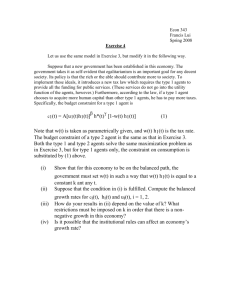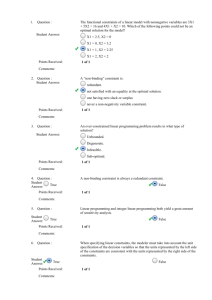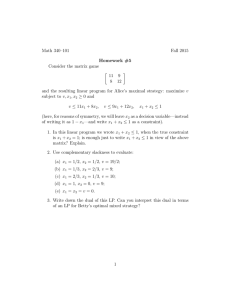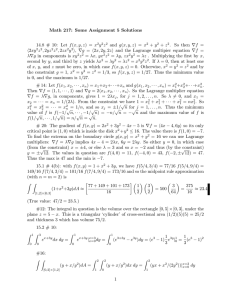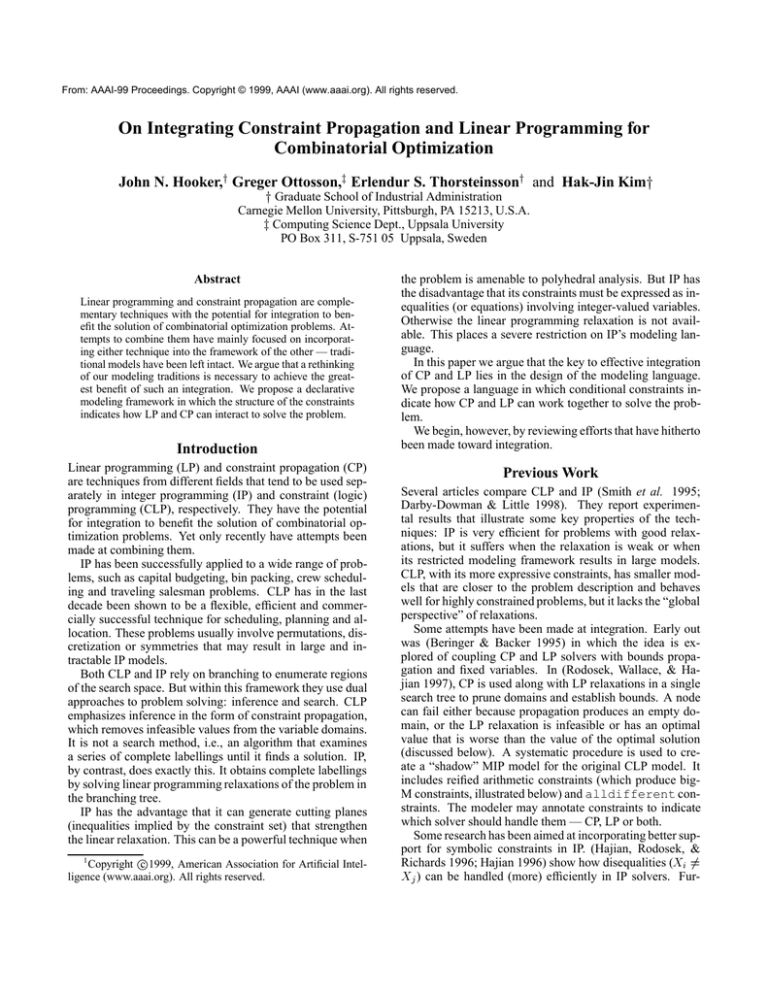
From: AAAI-99 Proceedings. Copyright © 1999, AAAI (www.aaai.org). All rights reserved.
On Integrating Constraint Propagation and Linear Programming for
Combinatorial Optimization
John N. Hooker,y Greger Ottosson,z Erlendur S. Thorsteinssony and Hak-Jin Kimy
y Graduate School of Industrial Administration
Carnegie Mellon University, Pittsburgh, PA 15213, U.S.A.
z Computing Science Dept., Uppsala University
PO Box 311, S-751 05 Uppsala, Sweden
Abstract
Linear programming and constraint propagation are complementary techniques with the potential for integration to benefit the solution of combinatorial optimization problems. Attempts to combine them have mainly focused on incorporating either technique into the framework of the other — traditional models have been left intact. We argue that a rethinking
of our modeling traditions is necessary to achieve the greatest benefit of such an integration. We propose a declarative
modeling framework in which the structure of the constraints
indicates how LP and CP can interact to solve the problem.
Introduction
Linear programming (LP) and constraint propagation (CP)
are techniques from different fields that tend to be used separately in integer programming (IP) and constraint (logic)
programming (CLP), respectively. They have the potential
for integration to benefit the solution of combinatorial optimization problems. Yet only recently have attempts been
made at combining them.
IP has been successfully applied to a wide range of problems, such as capital budgeting, bin packing, crew scheduling and traveling salesman problems. CLP has in the last
decade been shown to be a flexible, efficient and commercially successful technique for scheduling, planning and allocation. These problems usually involve permutations, discretization or symmetries that may result in large and intractable IP models.
Both CLP and IP rely on branching to enumerate regions
of the search space. But within this framework they use dual
approaches to problem solving: inference and search. CLP
emphasizes inference in the form of constraint propagation,
which removes infeasible values from the variable domains.
It is not a search method, i.e., an algorithm that examines
a series of complete labellings until it finds a solution. IP,
by contrast, does exactly this. It obtains complete labellings
by solving linear programming relaxations of the problem in
the branching tree.
IP has the advantage that it can generate cutting planes
(inequalities implied by the constraint set) that strengthen
the linear relaxation. This can be a powerful technique when
1
Copyright c 1999, American Association for Artificial Intelligence (www.aaai.org). All rights reserved.
the problem is amenable to polyhedral analysis. But IP has
the disadvantage that its constraints must be expressed as inequalities (or equations) involving integer-valued variables.
Otherwise the linear programming relaxation is not available. This places a severe restriction on IP’s modeling language.
In this paper we argue that the key to effective integration
of CP and LP lies in the design of the modeling language.
We propose a language in which conditional constraints indicate how CP and LP can work together to solve the problem.
We begin, however, by reviewing efforts that have hitherto
been made toward integration.
Previous Work
Several articles compare CLP and IP (Smith et al. 1995;
Darby-Dowman & Little 1998). They report experimental results that illustrate some key properties of the techniques: IP is very efficient for problems with good relaxations, but it suffers when the relaxation is weak or when
its restricted modeling framework results in large models.
CLP, with its more expressive constraints, has smaller models that are closer to the problem description and behaves
well for highly constrained problems, but it lacks the “global
perspective” of relaxations.
Some attempts have been made at integration. Early out
was (Beringer & Backer 1995) in which the idea is explored of coupling CP and LP solvers with bounds propagation and fixed variables. In (Rodosek, Wallace, & Hajian 1997), CP is used along with LP relaxations in a single
search tree to prune domains and establish bounds. A node
can fail either because propagation produces an empty domain, or the LP relaxation is infeasible or has an optimal
value that is worse than the value of the optimal solution
(discussed below). A systematic procedure is used to create a “shadow” MIP model for the original CLP model. It
includes reified arithmetic constraints (which produce bigM constraints, illustrated below) and alldifferent constraints. The modeler may annotate constraints to indicate
which solver should handle them — CP, LP or both.
Some research has been aimed at incorporating better support for symbolic constraints in IP. (Hajian, Rodosek, &
Richards 1996; Hajian 1996) show how disequalities (Xi 6=
Xj ) can be handled (more) efficiently in IP solvers. Fur-
ther, they give a linear modeling of the alldifferent
constraint.
Bockmayr and Kasper propose an interesting framework
in (Bockmayr & Kasper 1998) for combining CLP and IP,
in which several approaches to integration or synergy are
possible. They investigate how symbolic constraints can be
incorporated into IP much as cutting planes are. They also
show how a linear system of inequalities can be used in CLP
by incorporating it as a symbolic constraint. They also discuss a closer integration in which both linear inequalities and
domains appear in the same constraint store.
Characterization
tightening the linear relaxation by adding bounds and cuts
in addition to classical cutting planes, and
eliminating search of symmetric solutions, which are often more easily excluded by using symbolic constraints.
LP can enhance the solver by
finding feasible solutions early in the search by “global
reasoning,” i.e., solution of an LP relaxation,
similarly providing stronger bounds that accelerate the
proof of optimality, and
providing reasons for failure or a poor solution, so as to
produce nogoods.
We start with a basic characterization of CLP and IP.
Constraint (Logic) Programming
In Finite Domain CLP each integer variable xi has an associated domain Di , which is the set of possible values this
variable can take on in the (optimal) solution. The cartesian product of the domains, D1 : : : Dn , forms the solution space of the problem. This space is finite and can be
searched exhaustively for a feasible or optimal solution, but
to limit this search CP is used to infer infeasible solutions
and prune the corresponding domains. From this viewpoint,
CP operates on the set of possible solutions and narrows it
down.
Integer Programming
In contrast to CLP, IP does not maintain and reduce a set
of solutions defined by variable domains. It generates a series of complete labellings, each obtained at a node of the
branching tree by solving a relaxation of the problem at that
node. The relaxation is usually constructed by dropping
some of the constraints, notably the integrality constraints
on the variables, and perhaps by adding valid constraints
(cutting planes) that make the relaxation tighter. In a typical application the relaxation is rapidly solved to optimality
with a linear programming algorithm.
If the aim is to find a feasible solution, branching continues until the solution of the relaxation happens to be feasible in the original problem (in particular, until it is integral).
Relaxations therefore provide a heuristic method for identifying solutions. In an optimization problem, relaxation also
provides bounds for a branch-and-bound search. At each
node of the branching tree, one can check whether the optimal value of the relaxation is better than the value of the
best feasible found so far. If not, there is no need to branch
further at that node.
The dual of the LP relaxation can also provide useful information, perhaps by fixing some integer variables or generating additional constraints (nogoods) in the form of “Benders cuts.” (Benders 1962; Geoffrion 1974). We will see
how the latter can be exploited in an integrated framework.
Comparison of CP and LP
CP can accelerate the search for a solution by
reducing variable domains (and in particular by proving
infeasibility),
Modeling for Hybrid Solvers
The approaches taken so far to integration of CP and LP are
(a) to use both models in parallel, and (b) to try to incorporate one within the other. The more fundamental question of
whether a new modeling framework should be used has not
yet been explored in any depth. The success of (a) depends
on the strength of the links between the models and to what
degree the overhead of having two models can be avoided.
Option (b) is limited in what it can achieve. The high-level
symbolic constraints of CLP cannot directly be applied in an
IP model, and the same holds for attempts to use IP’s cutting
planes and relaxations in CLP.
We will use a simple multiple-machine scheduling problem to illustrate the advantages of a new modeling framework. Assume that we wish to schedule n tasks for processing on as many as n machines. Each machine m runs at
speed rm . The objective is to minimize the total fixed cost
of the machines we use. Let Rj be the release time, Pj the
processing time for speed rm = 1 and Dj the deadline for
task j . Let Cm be the fixed cost of using machine m and tj
the start time of task j .
We first state an IP model, which uses 0–1 variables xij
to indicate the sequence in which the jobs are processed. Let
xij = 1 if task i precedes task j , i 6= j , on the same machine,
with xij = 0 otherwise. Also let 0–1 variable ymj = 1 if
task j is assigned to machine m, and 0–1 variable zm = 1 if
machine m is used. Then an IP formulation of this problem
is,
XC
m zm
m
s.t. zm ymj ;
min
X y = 1;
mj
m
X
t + Pj y
8m; j;
8j;
X
8j;
8i 6= j;
mj Dj ;
m rm
Rj tj ;
ti + rPi ymi tj +M (1,xij );
m m
xij + xji ymi + ymj , 1;
zm ; ymj ; xij 2 f0; 1g; tj 0;
j
(1)
(2)
8j;
8m; i < j;
8m; i; j:
(3)
(4)
Constraint (3) is a “big-M” constraint. If M is a sufficiently
large number, the constraint forces task i to precede task j if
xij = 1 and has no effect otherwise.
A CLP model for the same problem is
min
XC
m
s.t. if mi
m zm
mi
mj
(5)
tj + rPj Dj ;
8j;
m
Rj tj ;
8j;
if atleast(m;[m1 ; : : : ; mn ]; 1)
then zm = 1 else zm = 0;
8m; (6)
m; mj 2 f1; : : : ; ng; tj 0;
8j;
where mj is the machine assigned to task j . The CLP model
j
has the advantage of dispensing with the doubly-subscripted
0–1 variables xij and ymi , which are necessary in IP to represent permutations and assignments. This advantage can
be pronounced in larger problems. A notorious example is
the progressive party problem (Smith et al., 1995), whose IP
model requires an enormous number of multiply-subscripted
variables.
The IP model has the advantage of a useful linear programming relaxation, consisting of the objective function,
constraints (1)–(2), and bounds 0 ymj 1. The 0–1 variables ymj enlarge the model but compensate by making this
relaxation possible. However, the IP constraints involving
the permutation variables xij yield a very weak relaxation
and needlessly enlarge the LP relaxation.
Somehow we must combine the succinctness of the CLP
model with an ability to create a relaxation from that portion
of the IP model that has a useful relaxation. To do this we
propose taking a step back to investigate how one can design
a model to suit the solvers rather than adjust the solvers to
suit the traditional models.
Mixed Logical/Linear Programming
x 2 Rn ; y 2 D;
P
P
min cx
s.t. hi (y ) ! Li (x; y ); i 2 I;
x 2 Rn ; y 2 D;
where
Li (x; y) =
X
k2Ki (y)
aik (y)xj (y) bi (y):
ik
Note that the model also allows for a summation taken over
a variable index set Ki (y ), which is a set-valued function of
y, as well as real-valued “variable constants” bi (y).
Models of this sort can in principle be written in the more
primitive form (7) by adding sufficiently many conditional
constraints. For example, the constraint z j cjyj can be
written z j zj , if the following constraints are added to
the model
P
P
(yj = k) ! (zj = cjk ); all j; k 2 f1; : : :ng;
where each yj 2 f1; : : : ; ng. It is preferable, however, for
the solver to process variables subscripts and index sets directly.
The Solution Algorithm
We begin with the framework of Mixed Logical/Linear Programming (MLLP) proposed in (Hooker 1994; Hooker &
Osorio 1997; Hooker, Kim, & Ottosson 1998). It writes constraints in the form of conditionals that link the discrete and
continuous elements of the problem. A model has the form
min cx
s.t. hi (y ) ! Ai x bi ; i 2 I;
Similarly, an unconditional discrete
constraint h can be formally represented with the conditional
:h ! (1 = 0).
The absence of discrete variables from the objective function will be useful algorithmically. Costs that depend on
discrete variables can be represented with conditional constraints. For example, the objective function
j cj xj ,
where xj 2 f0; 1g, can be written j zj with constraints
(xj = 1) ! (zj = cj ) and zj 0 for all j .
A useful modeling device is a variable subscript, i.e., a
subscript that contains one or more discrete variables. For
example, if cjk is the cost of assigning worker k to job j , the
total cost of an assignment can be written j cjyj , where yj
is a discrete variable that indicates the worker assigned job j .
The value of cjyj is in effect a function of y = (y1 ; : : : :yn )
and can be written gj (y ), where function gj happens to depend only on yj . The MLLP model can incorporate this
device as follows:
P
= mj then
(ti + rPi tj ) _ (tj + rPj ti ); 8i; j;
(0 = 0) ! Ax b.
(7)
where y is a vector of discrete variables and x a vector of
continuous variables. The antecedents hi (y ) of the conditionals are constraints that can be treated with CP techniques. The consequents are linear inequality systems that
can be inserted into an LP relaxation.
A linear constraint set Ax b which is enforced unconditionally may be so written for convenience, with the understanding that it can always be put in the conditional form
An MLLP problem is solved by branching on the discrete
variables. The conditionals assign roles to CP and LP: CP
is applied to the discrete constraints to reduce the search
and help determine when partial assignments satisfy the antecedents. At each node of the branching tree, an LP solver
minimizes cx subject to the inequalities Ai x bi for which
hi (y) is determined to be true. This delayed posting of inequalities leads to small and lean LP problems that can be
solved efficiently. A feasible solution is obtained when the
truth value of every antecedent is determined, and the LP
solver finds an optimal solution subject to the enforced inequalities.
Computational tests reported in (Hooker & Osorio 1997)
suggest that an MLLP framework not only has modeling advantages but can often permit more rapid solution of the
problem than traditional MILP solvers. However, a number of issues are not addressed in this work, including: (a)
systematic implementation of variable subscripts and index
sets, (b) taking full advantage of the LP solution at each
node, and (c) branching on continuous variables and propagation of continuous constraints.
An Example
We can now formulate the multiple machine scheduling
problem discussed earlier in an MLLP framework. Let k index a sequence of events, each of which is the start of some
task. In the following model we will focus on the events, using mappings from events to tasks and events to machines,
respectively.
Events
Tasks
Machines
tk
sk
mk
(/ ).t1*- +, T T
T T T T j j j j j 4 1 V V V V V V Vi i i i i 4 M1
j j j T T T T T * i i i i i i V V V V *
(/ ).t2*- +, j j j
2
i i 4 M2
i i i i
i
i
i
(/ ).t3*- +,
/3i i
M3
Variable tk will now be the start time of event k , sk the
task that starts, and mk the machine to which it is assigned.
Xf
The formal MLLP model is,
min
s.t.
m
m
(mk = ml ) ! (tk + rPs tl ); 8k < l;
m
k
tk + rPs Ds ;
m
Rs tk ;
k
k
k
k
k
alldifferentfs1; : : :
fm = Cm ; fm 0;
k
; sn g;
k
8k;
8k;
8k; m:
The model shares CLP’s succinctness by dispensing with
doubly-subscripted variables. To obtain the relaxation afforded by IP, we can simply add the objective function and
constraints (1)–(2) to the model, and link the variables ymi
to the other variables logically in (10).
min
s.t.
XC
m
m zm
(mk = ml ) ! (tk + rPs tl ); 8k < l;
k
tk + rPs Ds ;
m
Rs tk ;
k
k
k
mk
k
alldifferentfs1; : : :
zm ymj ;
X y = 1;
mj
m
ymk sk = 1;
; sn g;
The framework for integration described in (Bockmayr &
Kasper 1998) provides an interesting perspective on MLLP.
The CLP literature distinguishes between primitive and nonprimitive constraints. Primitive constraints are “easy” constraints for which there are efficient (polynomial) satisfaction and optimization procedures. They are maintained in a
constraint store, which in finite-domain CLP consists simply
of variable domains. Propagation algorithms for nonprimitive constraints retrieve current domains from the store and
add the resulting smaller domains to the store.
In IP, linear inequalities over continuous variables are
primitive because they can be solved by linear programming.
The integrality conditions are (the only) nonprimitive constraints.
Bockmayr and Kasper propose two ways of integrating
LP and CP. The first is to incorporate the LP part of the
problem into a CLP framework as a nonprimitive constraint.
Thus LP becomes a constraint propagation technique. It accesses domains in the form of bounds from the constraint
store and add new bounds obtained by minimizing and maximizing single variable.
A second approach is to make linear inequalities primitive constraints. The constraint store contains continuous
inequality relaxations of the constraints but excludes integrality conditions. For example, discrete constraints x1 _ x2
and :x1 _ x2 could be represented in the constraint store
as inequalities x1 + x2 1 and (1 , x1 ) + x2 1 and
bounds 0 xj 1. If constraint propagation deduced
that x2 is true, the inequality x2 1 would be added to the
store. This is an instance of what has long been known as
“preprocessing” in MILP, which can therefore be viewed as
a special case of this second kind of integration.
MLLP is a third type of integration in which two constraint stores are maintained (see Figure 1). A classical fiNonprimitive
: : : Nonprimitive
Constraint
1 Rh R R
n
O
6 Constraint
O
R R R m m m m m
m mR R R R
R R R
m m m
vm m m
(
FD Store
LP Store
Figure 1: Constraint stores and nonprimitive constraints in
MLLP
8k;
8k;
8m; j;
8j;
A Perspective on MLLP
(8)
(9)
8k: (10)
P
The relaxation now minimizes m Cm zm subject to (8),
(9), 0 ymj 1, and ymj = 1 for all ymj fixed to 1
by (10). One can also add a number of additional valid constraints involving the ymj ’s and the tk ’s.
nite domain constraint store, SFD , contains domains, and
the LP constraint store, SLP , contains linear inequalities
and bounds. The nonprimitive constraints can access and
add to both constraint stores. Since only domain constraints
xi 2 Di exist in the FD store, integrality constraints can
remain therein as primitive constraints. There are no continuous variables in the CP store and no discrete variables
in the LP store. The conditional constraints of MLLP act as
the prime inference agents connecting the two stores, reading domains of the CP store and adding inequalities to the
LP store (Figure 2).
In the original MLLP scheme, the conditionals are unidirectional, in the sense that they infer from SFD and post
to SLP and not vice-versa. This is because the solution
algorithm branches on discrete variables. As the discrete
domains are reduced by branching, the truth value of more
antecedents is inferred by constraint propagation, and more
inequality constraints are posted. However, conditionals in
the opposite direction could also be used if one branched on
continuous variables by splitting intervals. The antecedents
would contain continuous numerical constraints (not necessarily linear inequalities), and the consequents would contain primitive discrete constraints, i.e., restrictions on discrete variable domains. The truth value of the antecedents
might be inferred using interval propagation.
We will next give two more examples of nonprimitive
constraints in MLLP; a generalized version of the element
constraint for handling variable subscripts, and a constraint
which derives nogoods from SLP .
Variable Subscripts
As seen before, MLLP provides variable subscripts as a
modeling component, but an expansion to conditional constraints is in most cases not tractable. Instead a nonprimitive constraint, or inference agent, can be designed to handle
variable subscripts more efficiently.
There are basically two cases in which a variable subscript can occur — in a discrete constraint or in a continuous inequality. In the former case it can either be a vector of constants or a vector of discrete variables; both of
these correspond to the traditional use of the element/3
(Marriott & Stuckey 1998) constraint found in all major CP
systems and libraries (e.g. (Dincbas et al. 1988; Carlsson
1995)). This constraint takes the form elementFD (I ,
[X1 ; : : : ; Xn ], Y ), where I is an integer variable with
domain DI = f1; : : : ; ng, indexing the list, and Y = XI .
Here we will consider the second case, elementLP (I ,
[X1 ; : : : ; Xn ], Y ), where I is still a discrete, indexing
variable, but xi and Y are continuous variables or constants.
Propagating this constraint can be done almost as before.
Let the interval [min(xi ); max(xi )] be the domain of xi .
Then upon change of the domain of I , we can compute
min = fmin(xi )ji 2 DI g
max =fmax(xi )ji 2 DI g
reading DI from the SCP and the adding new bounds
min Y
max
to SLP . Similarly, bounds of Y can be used to prune DI .
(Stronger bounds for variables in LP can be obtained by minimizing and maximizing the variable subject to the linear
inequalities in SLP , which for some cases might be beneficial.)
The important point here is not the details of how we can
propagate this constraint, but rather to exemplify how an inference agent can naturally access both constraint stores.
Infeasible LP
When the LP is infeasible, any dual solution specifies an
infeasible linear combination of the constraint set. For each
conditional constraint yi ! Ai x bi ; i 2 I where some
ax b 2 Ai x bi has a corresponding nonzero dual
multiplier, we can form the logical constraint
_ :y
i2I
i
This nogood (Tsang 1993) must be satisfied by any solution
of the problem, because its corresponding set of linear inequalities forms an infeasible combination. This scheme can
naturally be encapsulated within a nonprimitive constraint,
nogood, reading from SLP and writing to SFD . This agent
can collect, merge and maintain no-goods for any combination of nonzero dual values in any infeasible LP node, and
can infer primitive and nonprimitive constraints which will
strengthen SFD . A related use of the infeasible combination has previously been explored in the context of intelligent backtracking (De Backer & Beringer 1991). Figure 2
shows our nogood constraint and the other basic nonprimitive constraints of MLLP.
Element
O FD
3 ElementLP
3 Conditional
yi ! Ax b
FD Store
[
LP Store
W :yi
Nogood p
Figure 2: Nonprimitive constraints in MLLP
Feasible LP
In IP, the solution of the relaxation provides a complete labelling of the variables. This sort of labelling is not immediately available in MLLP, because the relaxation involves
of a feaonly continuous variables. However, the solution x
sible relaxation can be heuristically extended to a complete
labelling (
x; y) that may satisfy the constraints. (Because y
does not occur in the objective function, its value will not
affect the optimal value of the problem.) Given any conditional hi (y ) ! Ai x bi , hi (
y) must be false if Ai x 6 bi ,
bi . One can therefore
but it can be true or false if Ai x
employ a heuristic (or even an exhaustive search) that tries
to assign values yj to the yj ’s from their current domains so
as to falsify the antecedents that must be false.
Conclusion
LP and CP have long been used separately, but they have
the potential to be integrated as complementary techniques
in future optimization frameworks. To do this fully and in
general, the modeling traditions of mathematical programming and constraint programming also must be integrated.
We propose a unifying modeling and solution framework
that aims to do so. Continuous and discrete constraints are
naturally combined using conditional constraints, allowing
a clean separation and a natural link between constraints
amenable to CP and continuous inequalities efficiently handled by LP.
References
Benders, J. F. 1962. Partitioning procedures for solving mixed-variables programming problems. Numer. Math.
4:238–252.
Beringer, H., and Backer, B. D. 1995. Combinatorial
problem solving in constraint logic programming with cooperating solvers. In Beierle, C., and Plümer, L., eds.,
Logic Programming: Formal Methods and Practical Applications, Studies in Computer Science and Artificial Intelligence. Elsevier. chapter 8, 245–272.
Bockmayr, A., and Kasper, T. 1998. Branch-and-infer:
A unifying framework for integer and finite domain constraint programming. INFORMS J. Computing 10(3):287 –
300.
Carlsson, M. 1995. SICStus Prolog User’s Manual. SICS
research report, Swedish Institute of Computer Science.
URL: http://www.sics.se/isl/sicstus.html.
Darby-Dowman, K., and Little, J. 1998. Properties of
some combinatorial optimization problems and their effect on the performance of integer programming and constraint logic programming. INFORMS Journal on Computing 10(3):276–286.
De Backer, B., and Beringer, H. 1991. Intelligent backtracking for CLP languages: An application to CLP(R). In
Saraswat, V., and Ueda, K., eds., Logic Programming, Proceedings of the 1991 International Symposium, 405–419.
San Diego, USA: The MIT Press.
Dincbas, M.; Van Hentenryck, P.; Simonis, H.; Aggoun,
A.; Graf, T.; and Berthier, F. 1988. The Constraint Logic
Programming Language CHIP. In FGCS-88: Proceedings
International Conference on Fifth Generation Computer
Systems, 693–702. Tokyo: ICOT.
Geoffrion, A. 1974. Lagrangian relaxation for integer programming. Mathematical Programming Study 2:82–114.
Hajian, M.; Rodosek, R.; and Richards, B. 1996. Introduction of a new class of variables to discrete and integer
programming problems. Baltzer Journals.
Hajian, M. T. 1996. Dis-equality constraints in linear/integer programming. Technical report, IC-Parc.
Hooker, J. N., and Osorio, M. A. 1997. Mixed logical/linear programming. Discrete Applied Mathematics, to
appear.
Hooker, J. N.; Kim, H.-J.; and Ottosson, G. 1998. A declarative modeling framework that integrates solution methods.
Annals of Operations Research, Special Issue on Modeling
Languages and Approaches, to appear.
Hooker, J. N. 1994. Logic-based methods for optimization.
In Borning, A., ed., Principles and Practice of Constraint
Programming, volume 874 of Lecture Notes in Computer
Science, 336–349.
Marriott, K., and Stuckey, P. J. 1998. Programming with
Constraints: An Introduction. MIT Press.
Rodosek, R.; Wallace, M.; and Hajian, M. 1997. A new approach to integrating mixed integer programming and constraint logic programming. Baltzer Journals.
Smith, B.; Brailsford, S.; Hubbard, P.; and Williams, H. P.
1995. The Progressive Party Problem: Integer Linear Programming and Constraint Programming Compared. In
CP95: Proceedings 1st International Conference on Principles and Practice of Constraint Programming).
Tsang, E. 1993. Foundations of Constraint Satisfaction.
Academic Press.

